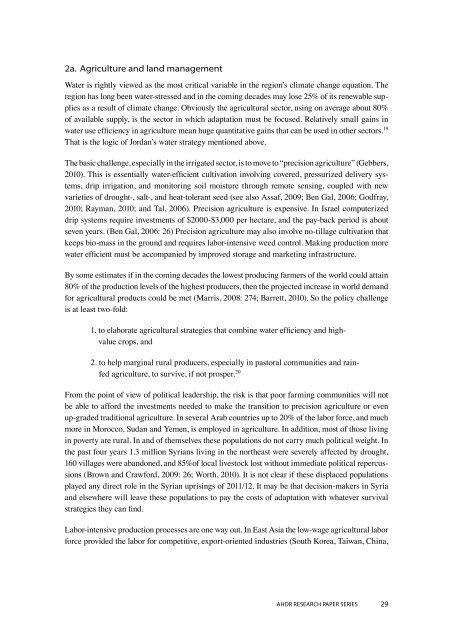The Political Economy of Climate Change in Arab Countries
The Political Economy of Climate Change in Arab Countries
The Political Economy of Climate Change in Arab Countries
You also want an ePaper? Increase the reach of your titles
YUMPU automatically turns print PDFs into web optimized ePapers that Google loves.
2a. Agriculture and land managementWater is rightly viewed as the most critical variable <strong>in</strong> the region’s climate change equation. <strong>The</strong>region has long been water-stressed and <strong>in</strong> the com<strong>in</strong>g decades may lose 25% <strong>of</strong> its renewable suppliesas a result <strong>of</strong> climate change. Obviously the agricultural sector, us<strong>in</strong>g on average about 80%<strong>of</strong> available supply, is the sector <strong>in</strong> which adaptation must be focused. Relatively small ga<strong>in</strong>s <strong>in</strong>water use efficiency <strong>in</strong> agriculture mean huge quantitative ga<strong>in</strong>s that can be used <strong>in</strong> other sectors. 19That is the logic <strong>of</strong> Jordan’s water strategy mentioned above.<strong>The</strong> basic challenge, especially <strong>in</strong> the irrigated sector, is to move to “precision agriculture” (Gebbers,2010). This is essentially water-efficient cultivation <strong>in</strong>volv<strong>in</strong>g covered, pressurized delivery systems,drip irrigation, and monitor<strong>in</strong>g soil moisture through remote sens<strong>in</strong>g, coupled with newvarieties <strong>of</strong> drought-, salt-, and heat-tolerant seed (see also Assaf, 2009; Ben Gal, 2006; Godfray,2010; Rayman, 2010; and Tal, 2006). Precision agriculture is expensive. In Israel computerizeddrip systems require <strong>in</strong>vestments <strong>of</strong> $2000-$3,000 per hectare, and the pay-back period is aboutseven years. (Ben Gal, 2006: 26) Precision agriculture may also <strong>in</strong>volve no-tillage cultivation thatkeeps bio-mass <strong>in</strong> the ground and requires labor-<strong>in</strong>tensive weed control. Mak<strong>in</strong>g production morewater efficient must be accompanied by improved storage and market<strong>in</strong>g <strong>in</strong>frastructure.By some estimates if <strong>in</strong> the com<strong>in</strong>g decades the lowest produc<strong>in</strong>g farmers <strong>of</strong> the world could atta<strong>in</strong>80% <strong>of</strong> the production levels <strong>of</strong> the highest producers, then the projected <strong>in</strong>crease <strong>in</strong> world demandfor agricultural products could be met (Marris, 2008: 274; Barrett, 2010). So the policy challengeis at least two-fold:1. to elaborate agricultural strategies that comb<strong>in</strong>e water efficiency and highvaluecrops, and2. to help marg<strong>in</strong>al rural producers, especially <strong>in</strong> pastoral communities and ra<strong>in</strong>fedagriculture, to survive, if not prosper. 20From the po<strong>in</strong>t <strong>of</strong> view <strong>of</strong> political leadership, the risk is that poor farm<strong>in</strong>g communities will notbe able to afford the <strong>in</strong>vestments needed to make the transition to precision agriculture or evenup-graded traditional agriculture. In several <strong>Arab</strong> countries up to 20% <strong>of</strong> the labor force, and muchmore <strong>in</strong> Morocco, Sudan and Yemen, is employed <strong>in</strong> agriculture. In addition, most <strong>of</strong> those liv<strong>in</strong>g<strong>in</strong> poverty are rural. In and <strong>of</strong> themselves these populations do not carry much political weight. Inthe past four years 1.3 million Syrians liv<strong>in</strong>g <strong>in</strong> the northeast were severely affected by drought,160 villages were abandoned, and 85%<strong>of</strong> local livestock lost without immediate political repercussions(Brown and Crawford, 2009: 26; Worth, 2010). It is not clear if these displaced populationsplayed any direct role <strong>in</strong> the Syrian upris<strong>in</strong>gs <strong>of</strong> 2011/12. It may be that decision-makers <strong>in</strong> Syriaand elsewhere will leave these populations to pay the costs <strong>of</strong> adaptation with whatever survivalstrategies they can f<strong>in</strong>d.Labor-<strong>in</strong>tensive production processes are one way out. In East Asia the low-wage agricultural laborforce provided the labor for competitive, export-oriented <strong>in</strong>dustries (South Korea, Taiwan, Ch<strong>in</strong>a,AHDR RESEARCH Paper series29
















